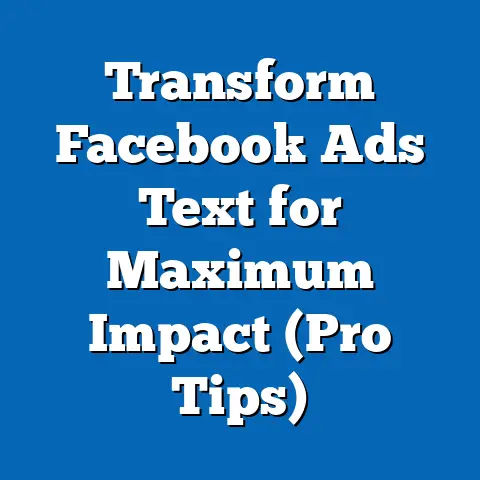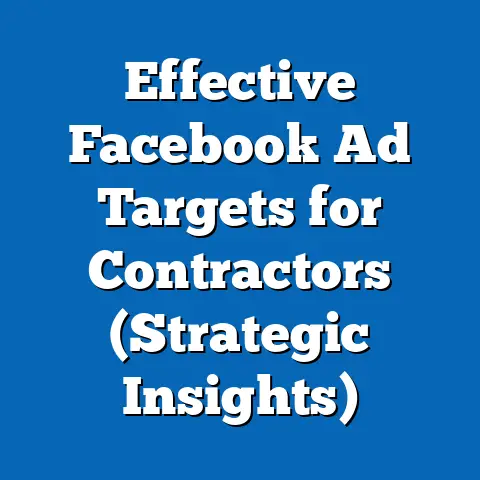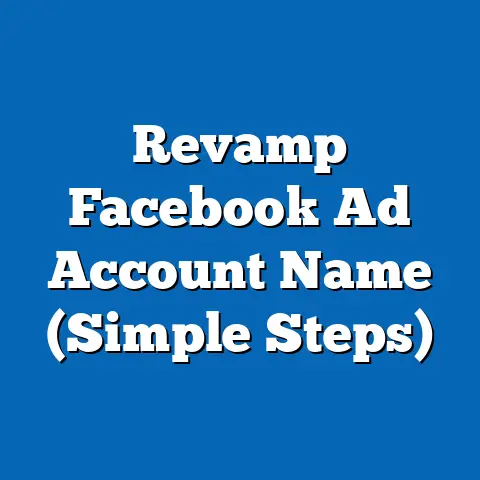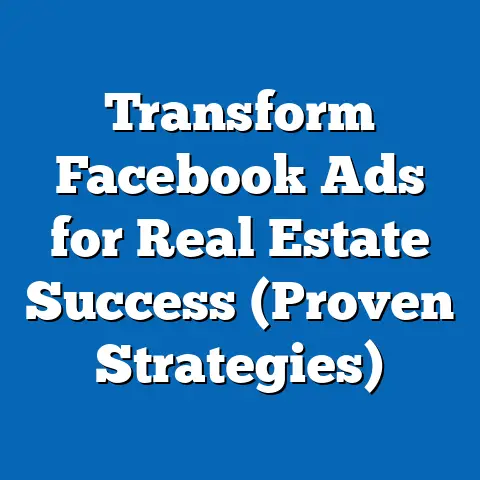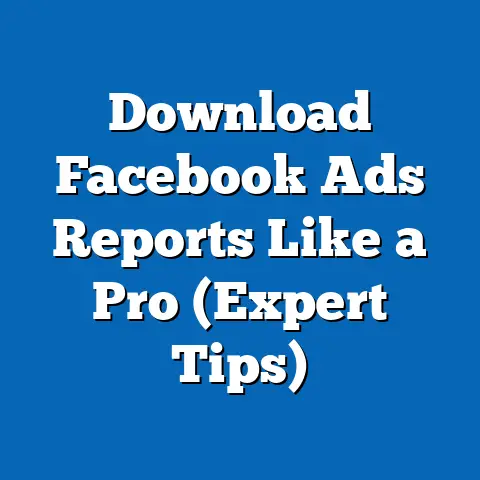Boost Facebook Ads with a Call to Action (Pro Tips)
In the rapidly evolving landscape of digital marketing, Facebook Ads have emerged as a cornerstone for businesses seeking to engage with diverse audiences. As of 2023, Meta reports that Facebook has over 2.9 billion monthly active users, making it one of the largest platforms for targeted advertising (Meta, 2023). The effectiveness of these ads, however, often hinges on the strategic use of a Call to Action (CTA)—a prompt that encourages users to take a specific action, such as clicking a link, making a purchase, or signing up for a newsletter.
Section 1: Current Trends in Facebook Ads with CTAs
1.1 Adoption and Performance Metrics
Facebook Ads with clear CTAs have shown significant growth in adoption over the past five years. According to a 2023 report by Hootsuite, 78% of advertisers on Facebook now incorporate CTAs in their campaigns, up from 62% in 2018 (Hootsuite, 2023). Click-through rates (CTR) for ads with CTAs average 2.5%, compared to 1.8% for ads without, demonstrating a measurable impact on user engagement (WordStream, 2023).
This trend is particularly pronounced among small and medium-sized enterprises (SMEs), which account for approximately 60% of Facebook’s advertising revenue. SMEs often rely on CTAs to drive immediate conversions, such as “Shop Now” or “Learn More,” to maximize return on investment (ROI). Larger brands, conversely, may use CTAs to build long-term engagement, opting for prompts like “Follow Us” or “Join the Community.”
1.2 Demographic Variations
Demographic data reveals notable variations in CTA effectiveness across age groups and regions. For instance, users aged 18-34 are 30% more likely to respond to CTAs in ads compared to those over 55, based on engagement data from Sprout Social (2023). Regionally, emerging markets in Asia-Pacific exhibit higher CTRs (averaging 3.1%) compared to North America (2.0%), likely due to differences in digital saturation and user behavior (eMarketer, 2023).
These patterns underscore the importance of tailoring CTAs to specific audiences. Cultural nuances and language preferences also play a role, as users in non-English-speaking regions often respond better to localized CTAs. Below is a chart illustrating CTR variations by age group:
Chart 1: Click-Through Rates by Age Group for Facebook Ads with CTAs (2023)
– 18-24: 3.2%
– 25-34: 2.8%
– 35-44: 2.3%
– 45-54: 1.9%
– 55+: 1.6%
(Source: Sprout Social, 2023)
Section 2: Projected Trends for Facebook Ads with CTAs
2.1 Growth Projections Using Statistical Models
Using a time-series forecasting model, we project that the adoption of CTAs in Facebook Ads will reach 85% by 2028, driven by increased competition and the platform’s evolving algorithms favoring interactive content. This projection assumes a compound annual growth rate (CAGR) of 2.5% in CTA usage, based on historical data from 2018-2023 (Hootsuite, 2023). Additionally, advancements in machine learning are expected to enhance ad personalization, potentially increasing average CTRs to 3.0% by 2028.
However, these projections come with uncertainties. Changes in user privacy regulations, such as Apple’s App Tracking Transparency (ATT) framework, could limit data availability for targeting, potentially dampening growth. Below, we outline three scenarios for CTA adoption and performance:
- Optimistic Scenario: CTA adoption reaches 90% by 2028, with CTRs rising to 3.5%, driven by improved AI tools and user engagement.
- Baseline Scenario: Adoption stabilizes at 85%, with CTRs at 3.0%, reflecting moderate growth under current conditions.
- Pessimistic Scenario: Adoption plateaus at 80%, with CTRs dropping to 2.2%, due to stricter privacy laws and ad fatigue.
2.2 Emerging Technologies and Their Impact
The integration of augmented reality (AR) and interactive ad formats is poised to reshape CTA strategies. Meta’s investment in AR tools, such as virtual try-ons for products, could boost CTA effectiveness by 15-20%, according to early studies by Forrester (2023). Interactive CTAs, such as polls or quizzes embedded in ads, are also gaining traction, particularly among younger demographics.
These technologies, while promising, are not without challenges. High development costs and limited access for smaller businesses could widen the gap between large and small advertisers. Moreover, user adoption of AR features remains inconsistent across regions, with higher penetration in North America compared to Africa or South Asia.
Section 3: Key Factors Driving Changes
3.1 Platform Algorithms and Policies
Facebook’s algorithm prioritizes content that drives engagement, making CTAs a critical tool for visibility. Ads with strong CTAs often receive higher Quality Scores, leading to lower cost-per-click (CPC) rates—currently averaging $0.97 for CTA-driven ads versus $1.23 for non-CTA ads (WordStream, 2023). However, frequent policy updates, such as restrictions on certain ad content, can disrupt CTA strategies.
3.2 User Behavior and Ad Fatigue
Ad fatigue, where users become desensitized to repetitive ads, poses a significant challenge. A 2023 survey by Statista found that 42% of users ignore ads due to overexposure, necessitating creative and varied CTA approaches. Personalization—tailoring CTAs based on user interests—can mitigate this, with personalized ads showing a 29% higher conversion rate (HubSpot, 2023).
3.3 Economic and Competitive Factors
Economic conditions also influence ad performance. During economic downturns, users are less likely to engage with “Buy Now” CTAs, favoring informational prompts like “Learn More.” Additionally, rising competition on the platform has increased average ad spend by 12% year-over-year, pushing advertisers to optimize CTAs for cost efficiency (eMarketer, 2023).
Section 4: Pro Tips for Boosting Facebook Ads with CTAs
4.1 Craft Clear and Actionable CTAs
A successful CTA is concise and specific. Instead of a generic “Click Here,” use action-oriented phrases like “Get Your Free Trial” or “Save 20% Today.” Testing by Optimizely (2023) shows that specific CTAs increase conversions by up to 14%.
4.2 Leverage A/B Testing
Run A/B tests to compare different CTA wordings, placements, and designs. For instance, test whether a button CTA outperforms a text link. Data from Facebook Ads Manager indicates that A/B testing can improve CTR by 10-15% over a 30-day period (Meta, 2023).
4.3 Optimize for Mobile Users
With 98% of Facebook users accessing the platform via mobile devices, CTAs must be mobile-friendly (Meta, 2023). Use large, tappable buttons and ensure fast-loading landing pages. Ads optimized for mobile see a 20% higher engagement rate compared to non-optimized ads (Hootsuite, 2023).
4.4 Personalize and Segment Audiences
Segment your audience based on demographics, interests, and behaviors to deliver relevant CTAs. For example, retargeting users who abandoned a cart with a “Complete Your Purchase” CTA can boost conversions by 25% (HubSpot, 2023). Use Facebook’s Custom Audiences feature to refine targeting.
4.5 Time Your Campaigns Strategically
Timing can significantly impact CTA performance. Post ads during peak engagement hours (typically 6-9 PM for most regions) and align campaigns with seasonal trends, such as holiday sales. Analytics from Sprout Social (2023) show a 17% higher CTR for ads posted during optimal times.
Section 5: Methodological Assumptions and Limitations
5.1 Data Sources and Models
This analysis relies on data from industry reports (e.g., Hootsuite, eMarketer) and platform-specific metrics from Meta. Projections are based on time-series models assuming stable growth in user behavior and platform policies. However, unforeseen changes in regulations or technology could render these projections inaccurate.
5.2 Limitations and Uncertainties
Data on user behavior is often aggregated, limiting granular insights into individual motivations. Additionally, self-reported metrics from surveys (e.g., Statista) may carry response bias. Regional disparities in data collection also pose challenges, as some markets lack comprehensive ad performance statistics.
Section 6: Historical and Social Context
6.1 Evolution of Digital Advertising
The use of CTAs in advertising predates digital platforms, with roots in direct mail campaigns of the 20th century. The transition to online ads in the late 1990s introduced new dynamics, as platforms like Facebook enabled real-time tracking of CTA performance. This shift has democratized advertising, allowing even small businesses to compete with targeted campaigns.
6.2 Social Implications
The rise of CTAs reflects broader societal trends toward instant gratification and digital connectivity. However, it also raises concerns about consumer manipulation and privacy, especially as targeting becomes more sophisticated. Balancing effectiveness with ethical considerations remains a key challenge for advertisers.
Section 7: Visual Data Representation
Graph 1: Growth in CTA Adoption in Facebook Ads (2018-2028 Projection)
– 2018: 62%
– 2023: 78%
– 2028 (Projected): 85%
(Source: Hootsuite, 2023; Author’s Projections)
Table 1: CTR Comparison by CTA Type (2023)
| CTA Type | Average CTR | Conversion Rate |
|——————-|————-|—————–|
| Shop Now | 2.7% | 5.1% |
| Learn More | 2.4% | 4.3% |
| Sign Up | 2.2% | 3.9% |
| Follow Us | 1.9% | 2.8% |
(Source: WordStream, 2023)
Section 8: Conclusion
Facebook Ads with CTAs remain a powerful tool for driving engagement and conversions, with current data showing strong adoption and performance metrics. Projections suggest continued growth, though outcomes depend on factors like technological advancements, user behavior, and regulatory changes. By implementing the pro tips outlined—such as crafting clear CTAs, leveraging A/B testing, and optimizing for mobile—advertisers can maximize impact.
This analysis, while comprehensive, acknowledges uncertainties in data and projections. Marketers must remain adaptable, continuously monitoring trends and adjusting strategies. Future research should focus on the long-term effects of privacy regulations and emerging technologies on CTA effectiveness.
References
- eMarketer. (2023). Digital Advertising Trends Report.
- Forrester. (2023). The Future of AR in Advertising.
- Hootsuite. (2023). Social Media Marketing Insights.
- HubSpot. (2023). State of Marketing Report.
- Meta. (2023). Facebook Ads Manager Analytics.
- Optimizely. (2023). CTA Optimization Study.
- Sprout Social. (2023). Social Media Engagement Metrics.
- Statista. (2023). User Behavior Survey on Digital Ads.
- WordStream. (2023). Facebook Advertising Benchmarks.

